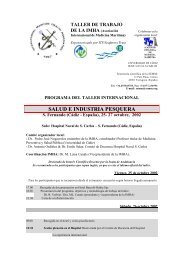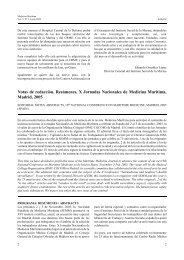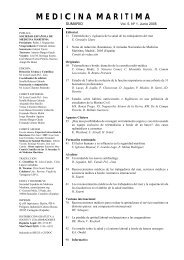MARCAPASOS DISFUNCIONANTE. TIPOS DE ... - SEMM
MARCAPASOS DISFUNCIONANTE. TIPOS DE ... - SEMM
MARCAPASOS DISFUNCIONANTE. TIPOS DE ... - SEMM
You also want an ePaper? Increase the reach of your titles
YUMPU automatically turns print PDFs into web optimized ePapers that Google loves.
<strong>MARCAPASOS</strong><br />
Dr. Juan José Fernández Domínguez.<br />
Médico de Emergencias. Grupo de Trabajo Cardio-Vascular.<br />
SUMMA 112.
<strong>MARCAPASOS</strong> <strong>DISFUNCIONANTE</strong>.<br />
INTRODUCCIÓN.<br />
¿Que es un Marcapasos?<br />
El marcapasos es un dispositivo<br />
electrónico que puede implantarse en<br />
el cuerpo humano sin riesgos de<br />
rechazo por parte del organismo pues<br />
están construidos con materiales<br />
biocompatibles.<br />
Los marcapasos generan un pulso que es entregado al<br />
corazón para producir un latido siempre y cuando el<br />
corazón no este latiendo espontáneamente.
<strong>MARCAPASOS</strong> <strong>DISFUNCIONANTE</strong>.<br />
INTRODUCCIÓN.<br />
Consta de dos partes:<br />
1.El generador de pulsos, que es el encargado de emitir pulsos<br />
eléctricos a un ritmo ordenado para reestablecer el latido cardiaco.
<strong>MARCAPASOS</strong> <strong>DISFUNCIONANTE</strong>.<br />
2. El/los catéteres (o sondas), que están constituidos por filamentos<br />
metálicos conductores de electricidad que conectan el generador de<br />
pulsos con el corazón, y es el encargado de hacer llegar los pulsos<br />
eléctricos al interior del mismo; de la misma manera que lleva el impulso<br />
eléctrico al corazón puede observar si el corazón esta latiendo<br />
espontáneamente o no y de esta manera "informar" al generador si es<br />
necesario emitir pulsos eléctricos.<br />
Electrodo<br />
Estimulación<br />
del miocardio
<strong>MARCAPASOS</strong> <strong>DISFUNCIONANTE</strong>.
<strong>MARCAPASOS</strong> <strong>DISFUNCIONANTE</strong>.<br />
CATETER<br />
AURICULA<br />
<strong>DE</strong>RECHA<br />
VENTRICULO<br />
<strong>DE</strong>RECHO<br />
GENERADOR<br />
ESTIMULACION <strong>DE</strong>L MIOCARDIO
<strong>MARCAPASOS</strong> <strong>DISFUNCIONANTE</strong>.
<strong>MARCAPASOS</strong> <strong>DISFUNCIONANTE</strong>.<br />
INTRODUCCIÓN.<br />
¿Qué quieres que haga<br />
un marcapasos?<br />
1. Que estimule a una<br />
FC determinada<br />
2. Que capture el<br />
corazón<br />
3. Que no estimule<br />
cuando no haga falta<br />
(se inhiba)<br />
4. Que intente<br />
sincronizar aurículas<br />
y ventrículos
<strong>MARCAPASOS</strong> <strong>DISFUNCIONANTE</strong>.<br />
Objetivo<br />
de un MP
<strong>MARCAPASOS</strong> <strong>DISFUNCIONANTE</strong>.<br />
<strong>TIPOS</strong> <strong>DE</strong> <strong>MARCAPASOS</strong>.<br />
Existen diferentes tipos de marcapasos que se<br />
indican de acuerdo a la necesidad y trastorno de<br />
cada paciente en particular. Están los marcapasos<br />
que llevan los estímulos eléctricos y/o monitorizan<br />
la presencia de latidos propios del paciente en una<br />
sola cámara del corazón (aurícula o ventrículo) por<br />
lo que son denominados UNICAMERALES y están<br />
los que entregan estímulos eléctricos y/o<br />
monitorizan la presencia de latidos propios del<br />
paciente en ambas cámaras y son denominados<br />
BICAMERALES. Los TRICAMERALES intentan<br />
sincronizar VD y VI con una tercera sonda que, por<br />
el ostium coronario, en la AD, llega a nivel<br />
epicárdico del VI.
<strong>MARCAPASOS</strong> <strong>DISFUNCIONANTE</strong>.
<strong>MARCAPASOS</strong> <strong>DISFUNCIONANTE</strong>.
<strong>MARCAPASOS</strong> <strong>DISFUNCIONANTE</strong>.<br />
ESpaña<br />
•E= Cámara<br />
Estimulada<br />
•S= Cámara<br />
Sensada
<strong>MARCAPASOS</strong> <strong>DISFUNCIONANTE</strong>.<br />
<strong>TIPOS</strong> <strong>DE</strong> <strong>MARCAPASOS</strong>.<br />
Cámara<br />
estimulada<br />
CODIFICACIÓN <strong>DE</strong> LOS <strong>MARCAPASOS</strong><br />
Cámara sensada<br />
(detectada)<br />
O (ninguna) O (ninguna) O (Ninguna)<br />
A (aurícula)<br />
A (aurícula)<br />
Respuesta a la<br />
detección<br />
T (Disparo)<br />
V (ventrículo) V (ventrículo) I (Inhibición)<br />
D (ambas A+V) D (ambas A+V) D (Ambas. T+I)<br />
Respuesta en<br />
frecuencia<br />
O (No)<br />
R ( Control<br />
automático de<br />
la frecuencia)<br />
The North American Society of Pacing and Electrophysiology and<br />
the British Pacing and Electrophysiology Group.
<strong>MARCAPASOS</strong> <strong>DISFUNCIONANTE</strong>.<br />
1.Unicamerales<br />
• AAI<br />
• VVI<br />
2.Bicamerales<br />
• VDD<br />
• DDD<br />
3.Tricamerales
<strong>MARCAPASOS</strong> <strong>DISFUNCIONANTE</strong>.<br />
Cuando se habla de<br />
marcapasos VVI se refiere<br />
a un marcapasos que<br />
entrega pulsos en la<br />
cámara Ventricular,<br />
monitoriza la presencia o<br />
no de latidos propios del<br />
paciente en la cámara<br />
Ventricular y responde<br />
Inhibiéndose si hay<br />
latidos propios del<br />
paciente.
<strong>MARCAPASOS</strong> <strong>DISFUNCIONANTE</strong>.<br />
Cuando el marcapasos es<br />
identificado como DDD se<br />
puede deducir que la<br />
estimulación es Doble (en<br />
ambas cámaras, aurícula y<br />
ventrículo), el sensado de<br />
la presencia de latidos<br />
propios del paciente en las<br />
cámaras es también Doble<br />
y el tipo de respuesta del<br />
marcapasos también será<br />
Doble.
<strong>MARCAPASOS</strong> <strong>DISFUNCIONANTE</strong>.<br />
CAPTURA AURICULAR
<strong>MARCAPASOS</strong> <strong>DISFUNCIONANTE</strong>.<br />
CAPTURA VENTRIUCLAR
<strong>MARCAPASOS</strong> <strong>DISFUNCIONANTE</strong>.<br />
CAPTURA AMBAS CAMARAS
<strong>MARCAPASOS</strong> <strong>DISFUNCIONANTE</strong>.<br />
¿Qué tipo de marcapasos es?. ¿Es normofuncionante o disfuncionante?
<strong>MARCAPASOS</strong> <strong>DISFUNCIONANTE</strong>.<br />
¿Qué tipo de marcapasos es?. ¿Es normofuncionante o disfuncionante?
<strong>MARCAPASOS</strong> <strong>DISFUNCIONANTE</strong>.<br />
¿Qué tipo de marcapasos es?. ¿Es normofuncionante o disfuncionante?
<strong>MARCAPASOS</strong> <strong>DISFUNCIONANTE</strong>.<br />
¿Qué tipo de marcapasos es?. ¿Es normofuncionante o disfuncionante?
<strong>MARCAPASOS</strong> <strong>DISFUNCIONANTE</strong>.<br />
¿Qué tipo de marcapasos es?. ¿Es normofuncionante o disfuncionante?
<strong>MARCAPASOS</strong> <strong>DISFUNCIONANTE</strong>.<br />
¿Qué tipo de marcapasos es?. ¿Es normofuncionante o disfuncionante?
<strong>MARCAPASOS</strong> <strong>DISFUNCIONANTE</strong>.<br />
¿Qué tipo de marcapasos es?. ¿Es normofuncionante o disfuncionante?
<strong>MARCAPASOS</strong> <strong>DISFUNCIONANTE</strong>.<br />
¿Qué tipo de marcapasos es?. ¿Es normofuncionante o disfuncionante?
<strong>MARCAPASOS</strong> <strong>DISFUNCIONANTE</strong>.<br />
¿Qué tipo de marcapasos es?. ¿Es normofuncionante o disfuncionante?
Disfunción del marcapasos
<strong>MARCAPASOS</strong> <strong>DISFUNCIONANTE</strong>.<br />
Fallos de captura.<br />
ECG que muestra espículas<br />
no acompañadas de<br />
complejos QRS (en caso de<br />
marcapasos con electrodos<br />
auriculares, la espícula de<br />
ésta no se seguiría de onda<br />
P estimulada).
<strong>MARCAPASOS</strong> <strong>DISFUNCIONANTE</strong>.<br />
Fallos de captura.
<strong>MARCAPASOS</strong> <strong>DISFUNCIONANTE</strong>.<br />
Fallos de captura.
<strong>MARCAPASOS</strong> <strong>DISFUNCIONANTE</strong>.<br />
Fallos de detección o de sensado (infradetección).<br />
• En los DDD*, AAI o VVI: especulas demasiado cerca del<br />
latido espontáneo previo. Recordar que tras un latido<br />
espontáneo, siempre ha de existir un intervalo de tiempo<br />
en que el marcapasos esté inhibido).<br />
• Pueden ser asintomáticos o provocar palpitaciones.<br />
Existe el peligro potencial de estimular durante el periodo<br />
vulnerable ventricular y desencadenar una TV/FV (raro<br />
fuera de un IAM).<br />
• En los marcapasos VDD* (estimulan el ventrículo tras<br />
detectar contracciones auriculares espontáneas), la<br />
infradetección auricular se manifiesta como ondas P<br />
bloqueadas (no seguidas del complejo QRS estimulado).<br />
-----------------------------------------------------------------------------------------------<br />
* Puede afectar tanto al sensado de la aurícula como del ventrículo.
<strong>MARCAPASOS</strong> <strong>DISFUNCIONANTE</strong>.<br />
Fallos de detección o de sensado (infradetección).
<strong>MARCAPASOS</strong> <strong>DISFUNCIONANTE</strong>.<br />
Fallos de detección o de sensado (infradetección).
<strong>MARCAPASOS</strong> <strong>DISFUNCIONANTE</strong>.<br />
¿Cuál es el problema?
<strong>MARCAPASOS</strong> <strong>DISFUNCIONANTE</strong>.<br />
¿Cuál es el problema?
<strong>MARCAPASOS</strong> <strong>DISFUNCIONANTE</strong>.<br />
¿Cuál es el problema?
<strong>MARCAPASOS</strong> <strong>DISFUNCIONANTE</strong>.<br />
¿Cuál es el problema?
<strong>MARCAPASOS</strong> <strong>DISFUNCIONANTE</strong>.
<strong>MARCAPASOS</strong> <strong>DISFUNCIONANTE</strong>.
<strong>MARCAPASOS</strong> <strong>DISFUNCIONANTE</strong>.<br />
¡Lo importante no es saber, …<br />
… sino tener el teléfono del que<br />
sabe!.<br />
“Les Luthiers”














